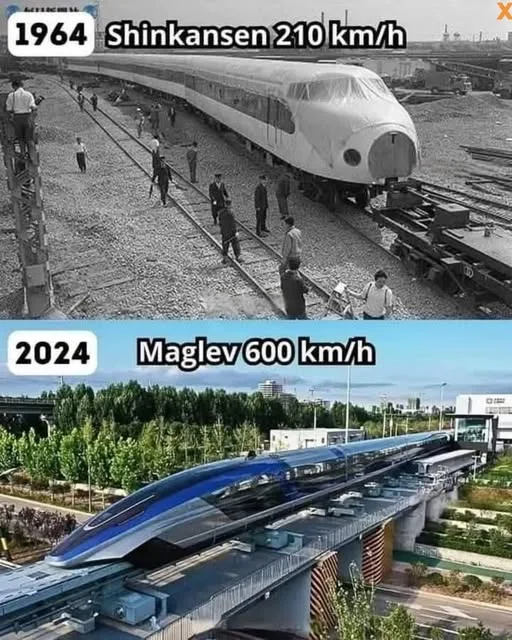In 1964, Japan unveiled a game-changer in transportation: the Shinkansen, the world’s first bullet train. Zooming along at 210 km/h (130 mph), it redefined rail travel, connecting cities with unprecedented speed and reliability. From its debut on the Tokaido Line between Tokyo and Osaka, the Shinkansen became a global symbol of innovation. Today, high-speed rail has evolved further, with magnetic levitation (Maglev) trains pushing speeds up to 600 km/h (373 mph). This blog post traces the Shinkansen’s groundbreaking legacy, explores the rise of Maglev technology, and looks ahead to how high-speed rail is shaping the future of transportation.

The Birth of the Shinkansen: A 1964 Milestone
The Shinkansen, or “new trunk line,” debuted on October 1, 1964, just in time for the Tokyo Olympics. Operated by Japan Railways (JR), the Series 0 train ran the 552 km (343 miles) between Tokyo and Osaka in about 4 hours, cutting travel time nearly in half compared to conventional trains. With its sleek, aerodynamic design—earning it the “bullet train” nickname—the Shinkansen was engineered for speed, safety, and efficiency.
Key features of the original Shinkansen included:
- Dedicated Tracks: Built without sharp curves or grade crossings to ensure smooth, high-speed travel.
- Advanced Safety Systems: An Automatic Train Control (ATC) system minimized human error, a novelty at the time.
- Passenger Comfort: Spacious cabins, smooth rides, and modern amenities set a new standard for rail travel.
The Tokaido Shinkansen’s success spurred Japan to expand the network, with lines now stretching across Honshu, Kyushu, and Hokkaido. By 2025, the Shinkansen carries millions annually, with models like the E5 Hayabusa reaching speeds of 320 km/h (199 mph).
The Global Impact of the Shinkansen
The Shinkansen inspired a global high-speed rail revolution. Countries like France (TGV, 1981), Germany (ICE, 1991), and China (CRH, 2007) developed their own systems, often drawing on Japan’s expertise. China’s high-speed rail network, now the world’s largest at over 45,000 km (28,000 miles), owes its rapid growth to the Shinkansen’s proof of concept. Meanwhile, nations like the U.S., India, and Morocco are investing in high-speed rail, inspired by its efficiency and environmental benefits.
The Shinkansen’s legacy extends beyond technology. It reshaped urban planning, boosting economic growth by connecting cities and reducing reliance on cars and planes. Its punctuality—delays are measured in seconds—remains a gold standard for rail systems worldwide.
The Rise of Maglev: The Next Frontier
While the Shinkansen set the benchmark for wheel-on-rail systems, magnetic levitation (Maglev) trains represent the next leap. Maglev trains use powerful electromagnets to levitate above the tracks, eliminating friction and enabling astonishing speeds. Two countries lead the charge:
- Japan: The SCMaglev, developed by JR Central, hit a world-record 603 km/h (375 mph) in a 2015 test. The Chuo Shinkansen, connecting Tokyo to Nagoya by 2027 and Osaka by 2037, will operate at 505 km/h (314 mph), slashing travel times (e.g., Tokyo-Nagoya in 40 minutes vs. 1 hour 40 minutes by Shinkansen).
- China: The Shanghai Maglev, operational since 2004, reaches 431 km/h (268 mph) on its 30 km (19-mile) airport route. China is expanding Maglev lines, with plans for intercity routes like Beijing-Shanghai.
Maglev’s advantages include:
- Speed: Up to 600 km/h, rivaling air travel for short-to-medium distances.
- Efficiency: Lower energy consumption per passenger-km than planes or cars, despite high initial costs.
- Smooth Rides: No track friction means quieter, more comfortable journeys.
Challenges remain, including astronomical construction costs (Japan’s Chuo Shinkansen is estimated at $90 billion) and the need for entirely new infrastructure. Still, Maglev promises to redefine regional connectivity.
The Future of High-Speed Rail
High-speed rail, from the Shinkansen to Maglev, is poised to shape the future of transportation. Key trends include:
- Sustainability: Electric-powered trains produce fewer emissions than cars or planes, aligning with global decarbonization goals. Maglev’s energy efficiency further reduces environmental impact.
- Urban Connectivity: High-speed rail links cities into “megaregions,” fostering economic growth. For example, Japan’s Maglev will integrate Tokyo, Nagoya, and Osaka into a single economic hub.
- Technological Innovation: Advances in AI, automation, and materials (e.g., lightweight composites) are making trains faster and safer. Hyperloop concepts, inspired by Maglev, aim for speeds exceeding 1,000 km/h in vacuum tubes, though they remain experimental.
- Global Expansion: Countries like India (Mumbai-Ahmedabad line, using Shinkansen tech), Thailand, and the UK are investing in high-speed rail. The U.S.’s Brightline West (Las Vegas-Los Angeles) aims to bring high-speed rail to the West Coast by 2028.
Challenges and Criticisms
Despite its promise, high-speed rail faces hurdles:
- Cost: Building dedicated tracks and stations is expensive, often requiring government subsidies. China’s massive network, for instance, has raised concerns about debt.
- Land Acquisition: Projects like Japan’s Maglev face resistance from landowners and environmental groups due to tunneling and ecosystem disruption.
- Competition: Budget airlines and electric vehicles challenge high-speed rail’s market share, especially in sprawling countries like the U.S.
Planning a Shinkansen or Maglev Experience
For travelers, riding the Shinkansen or Maglev is a bucket-list experience:
- Shinkansen: Book a Japan Rail Pass for unlimited travel on most Shinkansen lines. Try the Nozomi (fastest) or Green Car (first-class) for extra comfort. Popular routes include Tokyo-Kyoto (2h 20m) and Osaka-Hiroshima.
- Shanghai Maglev: A quick 8-minute ride from Pudong Airport to central Shanghai. Tickets cost about $7–$12 one-way.
- Tips: Book in advance during peak seasons (spring cherry blossoms, fall foliage). English signage and staff make Japan’s system tourist-friendly.
Conclusion
From the Shinkansen’s 1964 debut at 210 km/h to today’s Maglev trains pushing 600 km/h, high-speed rail has transformed how we move. Japan’s bullet train sparked a global revolution, proving that rail could rival air travel for speed and convenience. Now, with Maglev and emerging technologies, the future of transportation looks faster, greener, and more connected. Whether you’re marveling at the Shinkansen’s punctuality or experiencing the frictionless glide of a Maglev, high-speed rail invites us to reimagine distance and time. So, hop aboard—your journey into the future of travel starts here.
If you’d like details on specific Shinkansen routes, Maglev projects, or recent discussions about high-speed rail on X, let me know, and I’ll dig deeper!





